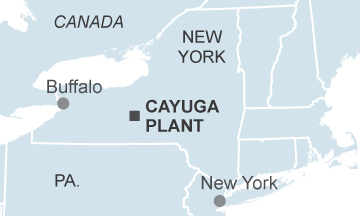 The New York Public Utility Commission made a good call yesterday in its decision not to permit a retrofit of the aging coal-fired Cayuga as a natural gas-burning facility.
The New York Public Utility Commission made a good call yesterday in its decision not to permit a retrofit of the aging coal-fired Cayuga as a natural gas-burning facility.
Our research around Cayuga last year demonstrated how the proposal to do a rate-payer financed makeover of the plant was economically unviable and would create a long-term drain on customers of New York State Electric & Gas Corp. The plan would have repowered the plant under a 10-year subsidy scheme that would have begun in 2017.
The PSC in its conclusion sounded themes similar to those we published last summer in our report on the proposal: “A Losing Proposition: Why the Proposal to Repower the Cayuga Plant Should be Rejected” (which was filed as public comment in the case by the Sierra Club).
Our core findings:
- A repowered Cayuga plant would have required ratepayer-supplied subsidies totaling more than $265 million by the end of the 10-year period of the proposal and could have required additional subsidies beyond 2027.
- The repowering project would not have state efforts to improve grid reliability.
- There are less expensive and far better ways to achieve electric grid reliability and to maintain the local tax base and jobs and promote economic development.
Yesterday’s statement on the decision by PSC Commission Chairwoman Audrey Zibelman does a good job at getting of the heart of the matter.
“We are very cognizant of the potential local economic effects of retiring power plants,” Zibelman said. “However, in this instance, the power plant itself does not solve our reliability concerns. Moreover, when we considered the combined lack of benefit to the power grid with the significantly higher costs of the refueling option, we determined it would simply be unfair to ask NYSEG consumers to shoulder both the transmission and refueling expense.”
The Cayuga repowering proposal was part of a larger and cynical industry pattern of seeking public subsidies for failing coal-fired power plants. Such schemes are out of step with the times as renewable energy becomes increasingly affordable and as grid efficiency improvements stand to make aging power plants unnecessary. In short, there are stronger alternatives to bailing out old, uneconomical coal plants like Cayuga.
Our report noted that the plant’s closure will create a fiscal challenge for the Lansing school district, for Tompkins County, for the Town of Lansing and for two service districts. Collectively, the public entities stand to lose an annual $1.8 million.
But our report shows also that ample state resources exist to help the community and workers weather the transition, and points out that the New York Power Authority has both the financial and energy planning resources to spearhead redevelopment.
David Schlissel is IEEFA’s director of resource planning analysis. Tom Sanzillo is IEEFA’s director of finance.

















